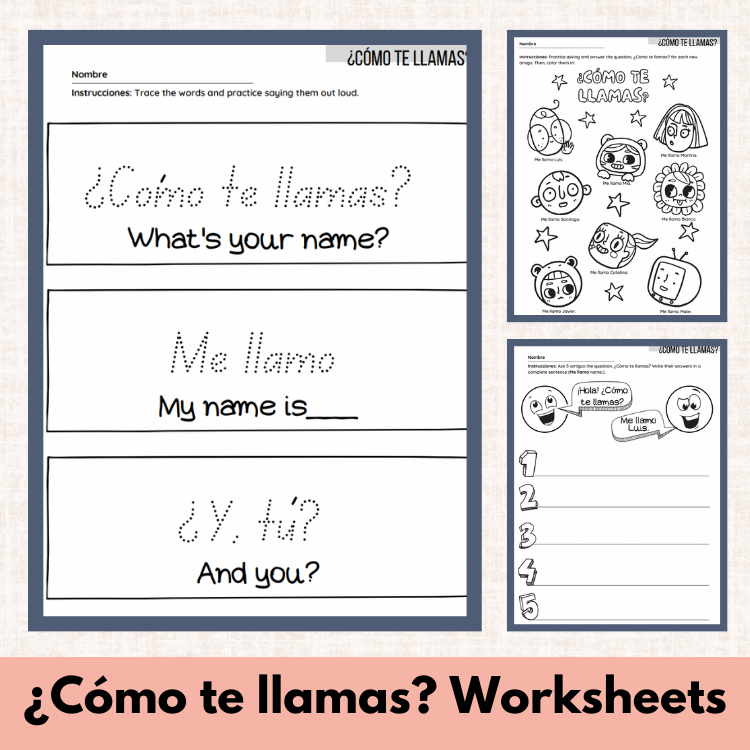Hey there, Joyful Journey Makers! Let’s talk about a powerful trifecta for reinforcing language acquisition—scaffolding, fine motor skills, and conversation. When used together, these techniques create a supportive learning environment that not only strengthens retention but also lowers stress. Students feel confident in their progress, knowing that they’re being guided step by step and given opportunities to practice in meaningful, hands-on ways.
In this post, we’ll explore the science behind why this combination works so well and how it can help students feel supported and engaged in their language learning journey. Plus, I’ll introduce my “¿Cómo te llamas?” Worksheets to show how this blend of strategies can be applied effectively in the classroom.
The Science Behind the Trifecta: Scaffolding, Fine Motor Skills, and Conversation
Why the Blend of These Three Techniques Strengthens Learning
Combining scaffolding, fine motor skills, and conversation creates a holistic learning experience. Here’s why:
- Retention Through Repetition: Scaffolding provides repetition without overwhelming students. By repeating tasks with gradually less support, students can process information at their own pace, helping them feel more confident as they learn. Incorporating fine motor skills through writing or tracing reinforces this repetition by engaging both the mind and body in the learning process.
- Lowering Stress and Building Confidence: Learning a new language can be intimidating, but scaffolding lowers the affective filter (a psychological barrier caused by stress or anxiety) by ensuring students feel supported along the way. As students master small tasks, they build confidence and take bigger leaps in their language skills.
- Real-World Application: Conversations help students practice language in a real-world context, giving them the opportunity to ask and answer questions naturally. Combining conversation with scaffolding and fine motor skills allows students to learn step by step and apply that learning in authentic ways.
Get Your Resource: "¿Cómo te llamas?" Worksheets
Looking for an easy way to integrate these three techniques into your classroom? My “¿Cómo te llamas?” Worksheets are designed to support students as they practice one of the most important conversational phrases in Spanish—introducing themselves!
What’s Included:
- Tracing and Fine Motor Practice: Students trace and practice writing the phrase “¿Cómo te llamas?” (What’s your name?) while simultaneously reinforcing their fine motor skills. Tracing helps students internalize the vocabulary while building hand-eye coordination.
- Structured Conversations: Each worksheet provides opportunities for students to practice asking and answering “¿Cómo te llamas?” with multiple classmates. This structured scaffolding guides them through simple conversations in a supportive way.
- Coloring Activities: After practicing introductions, students can color in their “amigos,” giving them a fun, hands-on activity that reinforces the vocabulary they just practiced. This helps engage kinesthetic learners while giving all students a creative break.
How to Use These Worksheets in Your Classroom
- Scaffolded Introduction Practice: Start by modeling how to ask and answer the question “¿Cómo te llamas?” with the class. Let students trace the sentence several times while you provide guidance. As they get more comfortable, remove the tracing support and have them write the question and answer independently.
- Conversational Pairs: Once students have practiced writing the phrase, pair them up to ask and answer “¿Cómo te llamas?” with each other. This turns a simple phrase into a real-world conversation, giving students authentic practice using language in context.
- Interactive Bulletin Board: After students complete their worksheets, create an interactive bulletin board where they can post their colored “amigos.” Each student’s sheet should include their introduction in Spanish, which will help reinforce the conversation they practiced and allow for continued vocabulary exposure in the classroom.
The Gist of it All
By combining scaffolding, fine motor skills, and conversation, you’re giving your students a comprehensive, low-stress way to practice their language skills. My “¿Cómo te llamas?” Worksheets provide the perfect blend of these strategies, ensuring that students feel supported as they practice and grow more confident in their Spanish abilities.

Resources
Hult, S. (2022, December 1). Scaffolding techniques for English language learners: Part 1. Collaborative Classroom. https://www.collaborativeclassroom.org/blog/scaffolding-techniques-english-language-learners-part-1/
Language acquisition: An overview. Colorín Colorado. (2020, February 18). https://www.colorincolorado.org/article/language-acquisition-overview
Lewis, R. (2020, November 4). What is comprehensible input and why does it matter for language learning?. Leonardo English. https://www.leonardoenglish.com/blog/comprehensible-input
Leon, D. (2024, August 15). Effective strategies: Scaffolding for ELL students that benefits the whole class. HMH. https://www.hmhco.com/blog/scaffolding-for-ell-students
Tower. (2024, April 17). 5 scaffolding strategies for Ell Students. Continental Educational Publisher. https://www.continentalpress.com/blog/scaffolding-strategies-for-ell-students/?srsltid=AfmBOopNXUAWdnpS_M7doMhohb9lZhfspoqKEGI5L04GzDEQ6HYH8oMU



